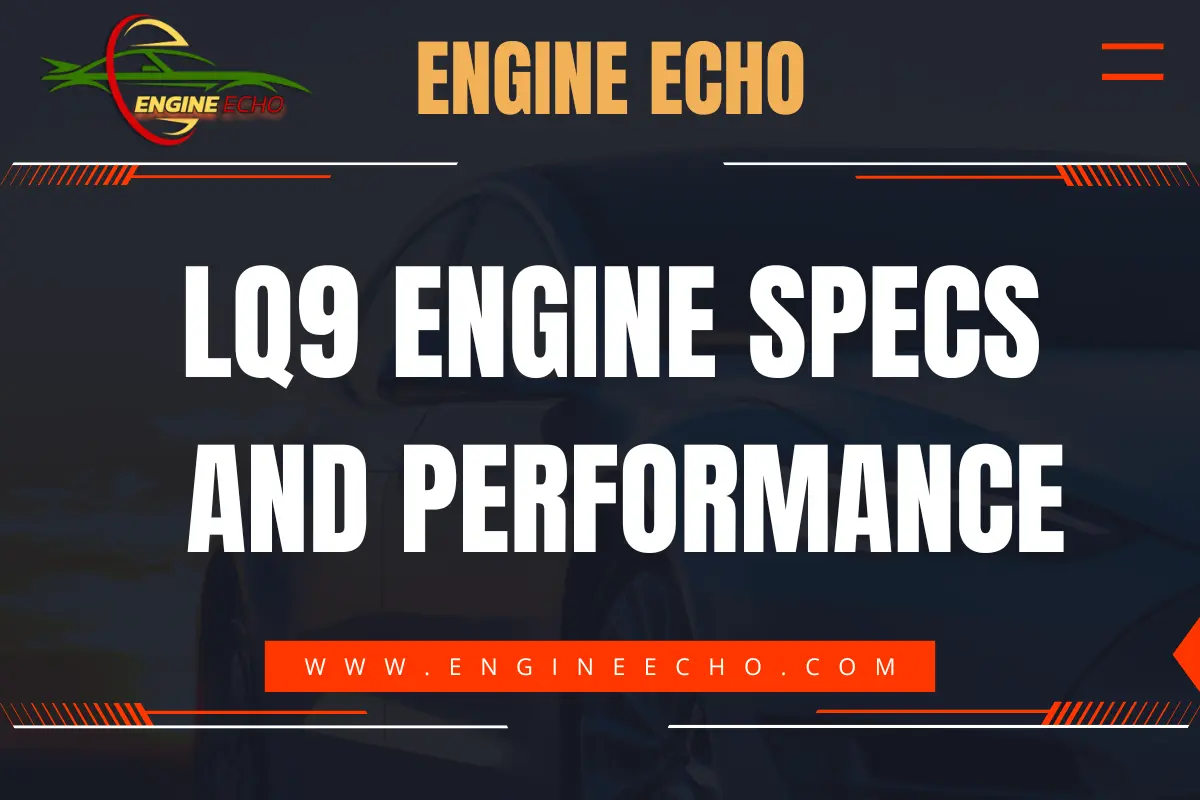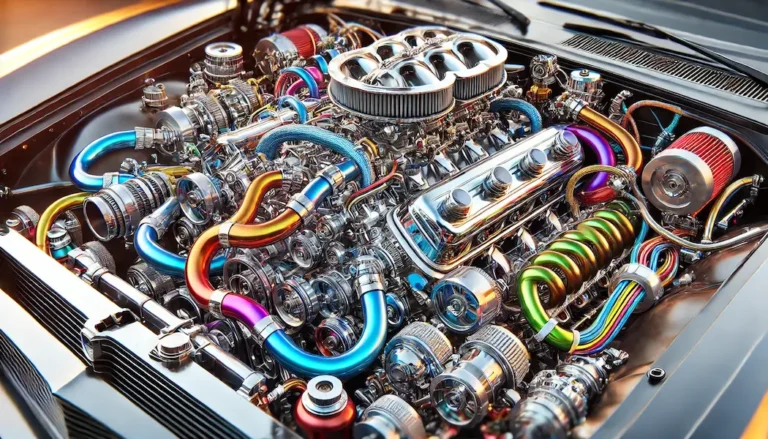LQ9 Engine: Specs and Performance

Key Takeaways:
- High Performance: The LQ9 engine delivers 345 horsepower and 380 lb-ft of torque, making it a powerful option for trucks and SUVs.
- Versatile Modifications: The LQ9 is favored in engine swaps and performance builds due to its durability and flexibility for modifications.
- Key Differences: Compared to its sibling, the LQ4, the LQ9 features a higher compression ratio and greater power output.
- Common Upgrades: The LQ9 benefits from easy bolt-on modifications like intake and exhaust upgrades, along with internal enhancements such as camshaft upgrades and forced induction.
- Reliability: Known for its longevity, the LQ9 is highly reliable when maintained properly, making it a favorite among enthusiasts.
Introduction
If you’re into serious power and performance, the LQ9 engine is one of those hidden gems you just can’t ignore. It’s part of GM’s LS family, and while it’s built for trucks and SUVs, its versatility and durability make it a go-to for all kinds of projects. I’ve had my hands on more than a few LQ9s, and I’ve never been disappointed. Whether you’re upgrading a build or doing a full engine swap, this powerhouse delivers every time. Let me walk you through why the LQ9 stands out, from its raw specs to how it performs once you start tweaking it.
1. History and Development of the LQ9 Engine
Origins
The LQ9 hit the scene in 2002 as part of GM’s LS family. This engine was built to give premium trucks and SUVs that extra muscle they needed to stand out. What sets the LQ9 apart is its cast-iron block, which gives it the toughness needed for heavy-duty applications. The first time I came across the LQ9 was in a Cadillac Escalade, and honestly, I was impressed by how effortlessly it combined smooth power delivery with the sheer force that you need in a performance engine.
Applications
The LQ9 found a home in some of GM’s premium vehicles, such as:
- Cadillac Escalade (2002–2006)
- Chevrolet Silverado SS (2003–2007)
- GMC Sierra Denali (2003–2006)
What I love about the LQ9 is how easily it fits into different builds. Whether you’re working with a classic muscle car or a modern truck, this engine just works.
2. Technical Specifications of the LQ9 Engine
Here are the specs that make the LQ9 a standout:
| Specification | Detail |
|---|---|
| Engine Type | Cast-iron block, aluminum heads |
| Displacement | 6.0 liters (364 cubic inches) |
| Bore and Stroke | 4.00 x 3.62 inches |
| Compression Ratio | 10.1:1 |
| Valvetrain | Overhead valve (OHV), 2 valves per cylinder |
| Horsepower | 345 hp at 5,200 rpm |
| Torque | 380 lb-ft at 4,000 rpm |
These numbers are impressive, but what really excites me is the potential this engine has for modifications. You can push this engine way beyond its stock form and still get reliable performance.
3. LQ9 vs. LQ4: Key Differences
The LQ9 and LQ4 engines share a lot of similarities, but there are some key differences that set the LQ9 apart:
- Compression Ratio: The LQ9 has a higher 10.1:1 compression ratio compared to the LQ4’s 9.4:1, and believe me, that bump in compression makes a difference in performance.
- Power Output: The LQ9 puts out 345 horsepower and 380 lb-ft of torque, while the LQ4 delivers a bit less. If you’re looking for that extra punch, the LQ9 gives you just that.
- Fuel Requirements: The LQ9 needs premium fuel to run optimally, so it’s a little more expensive at the pump, but the trade-off is well worth it if you want that extra power.
4. Performance Characteristics of the LQ9 Engine
This engine isn’t just about specs on paper—it’s about how it feels behind the wheel. I’ve driven a few LQ9-powered vehicles, and the power delivery is smooth yet powerful:
- Horsepower: With 345 horsepower, the LQ9 gets things moving quickly, especially in heavier vehicles. Whether you’re cruising on the highway or towing, this engine responds immediately.
- Torque: That 380 lb-ft of torque is really where the LQ9 shines. You feel it right off the line, and that low-end grunt makes it perfect for towing or launching off the block.
- Smooth Power Delivery: The LQ9 doesn’t throw you back in your seat aggressively, but it gets you up to speed with authority. It’s powerful, but in a way that feels controlled, which I’ve always appreciated in builds that use this engine.
5. Modifications and Upgrades for the LQ9 Engine
Now, let’s talk about how much fun you can have modifying the LQ9. I’ve done a few tweaks myself, and it’s always satisfying to see how much you can unlock with the right upgrades:
Bolt-On Modifications
- Cold Air Intakes: One of the easiest upgrades you can do, and you’ll feel the difference immediately. I love how adding a cold air intake gives you a little more pep and responsiveness.
- Exhaust System Upgrades: A performance exhaust is a must-have if you want to let this engine breathe better. Not only does it boost horsepower, but the sound you get is music to any gearhead’s ears.
- Performance Tuning: ECU remapping is where the magic happens. I’ve seen solid gains just from tuning, and it’s one of the best ways to get more power without getting too deep into the engine.
Internal Upgrades
- Camshaft Upgrades: I’m a big fan of cam upgrades for the LQ9. It completely changes the engine’s character, giving you more aggressive power delivery and a wider power band.
- Cylinder Heads: Aftermarket heads can make a huge difference. I’ve seen builds that gained significant horsepower just by swapping to performance heads.
- Forced Induction: If you really want to go all out, supercharging or turbocharging the LQ9 turns it into a monster. I’ve worked on turbocharged LQ9 builds that easily push over 600 horsepower—it’s a blast.
6. LQ9 Engine in High-Performance Builds
The LQ9 isn’t just for trucks and SUVs—it’s found its way into all sorts of high-performance builds, and for good reason:
- Street Performance: Dropping an LQ9 into a muscle car or restomod project is one of the best ways to bring old-school style into the modern performance world. The engine’s power is instantly noticeable, whether you’re on the street or the strip.
- Racing Applications: The LQ9 shines in racing environments. I’ve seen it hold its own on the drag strip and in street races, especially when paired with a few performance mods.
- Engine Swaps: Engine swaps are where the LQ9 really shows its versatility. I’ve worked on several swaps where the LQ9 was the star, and it fit perfectly into everything from classic muscle cars to off-road rigs.
7. Fuel Efficiency and Emissions
I’m not going to lie—fuel efficiency isn’t the LQ9’s strong suit. But if you’re looking at this engine, you’re probably more interested in horsepower than miles per gallon:
- Fuel Consumption: The LQ9 needs premium fuel, and with its 6.0-liter displacement, you’re going to feel it at the pump. But hey, power comes at a cost, and in this case, it’s a cost I’m more than happy to pay.
- Emissions: It’s not the cleanest engine, but upgrading your catalytic converter and keeping the engine properly tuned can help reduce emissions. The LQ9’s emissions profile is more in line with what you’d expect from a performance engine of its era.
8. Maintenance and Common Issues
If you want to keep the LQ9 running smoothly, regular maintenance is a must. I’ve learned this the hard way, but staying on top of a few things can save you big time:
- Lifter Failure: Lifter issues can pop up with the LQ9, and I’ve dealt with it a couple of times. If you catch it early, it’s a relatively easy fix, but ignoring it will only make things worse.
- Oil Consumption: Some LQ9s are known to burn oil, so I always keep an eye on oil levels. A little vigilance here can save you from bigger headaches later.
- Cooling System Issues: If you’re pushing the engine hard, overheating can become an issue. Upgrading the cooling system, especially if you’re adding power, is a smart move.
9. Cost of Owning and Maintaining an LQ9 Engine
Owning an LQ9 isn’t cheap, but for the performance you get, it’s worth every dollar:
- Initial Purchase Price: Depending on condition, expect to pay between $2,000 and $4,000 for a used or remanufactured LQ9. For the power and reliability it offers, that’s a solid investment.
- Maintenance Costs: Regular maintenance can add up, especially if you run into issues like lifter failure. But if you stay on top of things, you can avoid costly repairs.
- Fuel Costs: Premium fuel is a must, and with the LQ9’s appetite for gas, you’ll be filling up more often than with smaller engines. But if performance is your goal, you’ll find the trade-off worthwhile.
10. Comparison with Other GM Engines (LS Series)
- LQ9 vs. LS1: The LS1 is lighter and more suited for sports cars, but the LQ9’s iron block gives it more strength and durability for heavier vehicles or high-performance builds.
- LQ9 vs. LS3: The LS3 is a more advanced engine, but I find the LQ9 to be more budget-friendly while still offering great performance.
- LQ9 vs. LS7: The LS7 is a beast of an engine, but if you’re looking for power without breaking the bank, the LQ9 offers a lot of value.
11. Popular Vehicles Using the LQ9 Engine
The LQ9 was originally featured in some of GM’s top-tier trucks and SUVs, including:
- Cadillac Escalade (2002–2006)
- Chevrolet Silverado SS (2003–2007)
- GMC Sierra Denali (2003–2006)
These days, I’ve seen LQ9 swaps in everything from classic Camaros to off-road Jeeps. Its versatility really makes it a favorite for all kinds of builds.
12. Future of the LQ9: Is It Still Relevant?
Even though it’s no longer in production, the LQ9 is still a popular choice for engine swaps and performance builds. Its durability, power, and modifiability keep it relevant, and I don’t see that changing anytime soon:
- Classic Appeal: The LQ9 is still highly sought after, especially for those who want a solid engine base with tons of upgrade potential.
- Durability: I’ve seen LQ9s with over 200,000 miles still running strong. With the right care, this engine can last you a long time.
Conclusion
The LQ9 engine isn’t just about power—it’s about how much potential it has for more. I’ve worked with a lot of engines over the years, and the LQ9 always delivers. Whether you’re building a muscle car, upgrading a truck, or doing a high-performance engine swap, the LQ9’s reliability and power make it a great choice. If you want an engine that can handle anything you throw at it and still come out roaring, the LQ9 is the way to go.
Case Studies
- Case Study 1: A 2004 Chevrolet Silverado SS with an LQ9 engine got a cold air intake and exhaust upgrade, bumping its horsepower to over 400. The owner reported a significant improvement in performance while maintaining daily drivability.
- Case Study 2: A 1969 Chevrolet Camaro received an LQ9 engine swap along with a supercharger. This build now pushes over 600 horsepower, showing just how much performance you can squeeze out of the LQ9.
Frequently Asked Questions (FAQs)
- What vehicles came with the LQ9 engine?
- The LQ9 powered premium GM trucks and SUVs, including the Cadillac Escalade and Chevrolet Silverado SS.
- Can the LQ9 engine be supercharged or turbocharged?
- Absolutely. The LQ9 responds really well to forced induction, and I’ve seen builds push over 600 horsepower with the right setup.
- How does the LQ9 compare to the LS series engines?
- The LQ9 offers more torque than the LS1 but is heavier due to its cast-iron block. It’s less advanced than the LS3 but offers great performance at a lower price.
- What are common problems with the LQ9 engine?
- The most common issues are lifter failure and oil consumption, but regular maintenance can help avoid major problems.
- Is the LQ9 engine good for high-performance builds?
- Definitely. It’s a favorite in the performance community due to its durability and modifiability. The LQ9 is perfect for muscle cars, restomods, and even racing applications.
Thanks for checking out this article on EngineEcho.com! Hope you found this article: "LQ9 Engine: Specs and Performance" helpful! If you liked it and want to dive into more car engine topics, head over to our homepage. There's always something new to discover in the world of engines. Enjoy your reading journey!
Check out our previous article: Ford Barra Engines for Sale: Your Best Options






